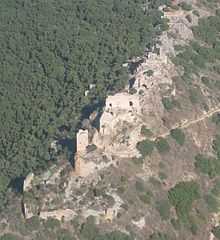Spur castle
A spur castle is a type of medieval fortification that uses its location as a defensive feature. The name refers to the location on a spur projecting from a hill. Ideally, a spur castle would be defended on three sides by steep hillsides, with the only vulnerable side the one where the spur joins the next hill.

Depending on the local topography, a spur castle may depend mostly on its inaccessible location, or combine it with defensive features such as walls and towers. A typical feature is a neck ditch cutting off the spur from the rest of the hill. When the spur is long and narrow, the term ridge castle is sometimes used as well. A long spur castle is sometimes, but not always, subdivided into a lower ward and a more strongly defended upper ward (or even a succession of more wards).
Examples of spur castles
- The crusader castle Krak des Chevaliers lies on the spur of a hill only accessible from the south. At the same time, it has strong concentric castle defences on all sides. (Kennedy 2000)
- In the castle at Saône, the defences are concentrated on the vulnerable side of the spur, most notably a deep ditch. The lower bailey at Saône has weaker walls and towers. (Nicole 2008)
- The Teutonic Knights' Montfort Castle is a narrow ridge castle that relies for its defence on the steep rocky hillsides, lacking many of the innovations of the larger crusader castles and resembling smaller German baronial castles. (Nicolle 2008)
- The Alcázar of Segovia in Spain which is located on a narrow spur with deep drops all around except from the east where it is approached on level ground.
- Stirling Castle in Scotland is located on a narrow spur with drops on three sides and a gentle slope providing access from the south-east.
- Château de Chinon in France was used by the counts of Anjou in the 12th century. In 1205, it was captured by the French King and was the largest castle in the Loire valley.
References
- Kennedy, Hugh (2000). Crusader Castles. Cambridge University Press. ISBN 0-521-79913-9.
- Nicolle, David (2008). Crusader Castles in the Holy Land. Osprey Publishing. ISBN 978-1-84603-349-0.
| ||||||||||||||||||||